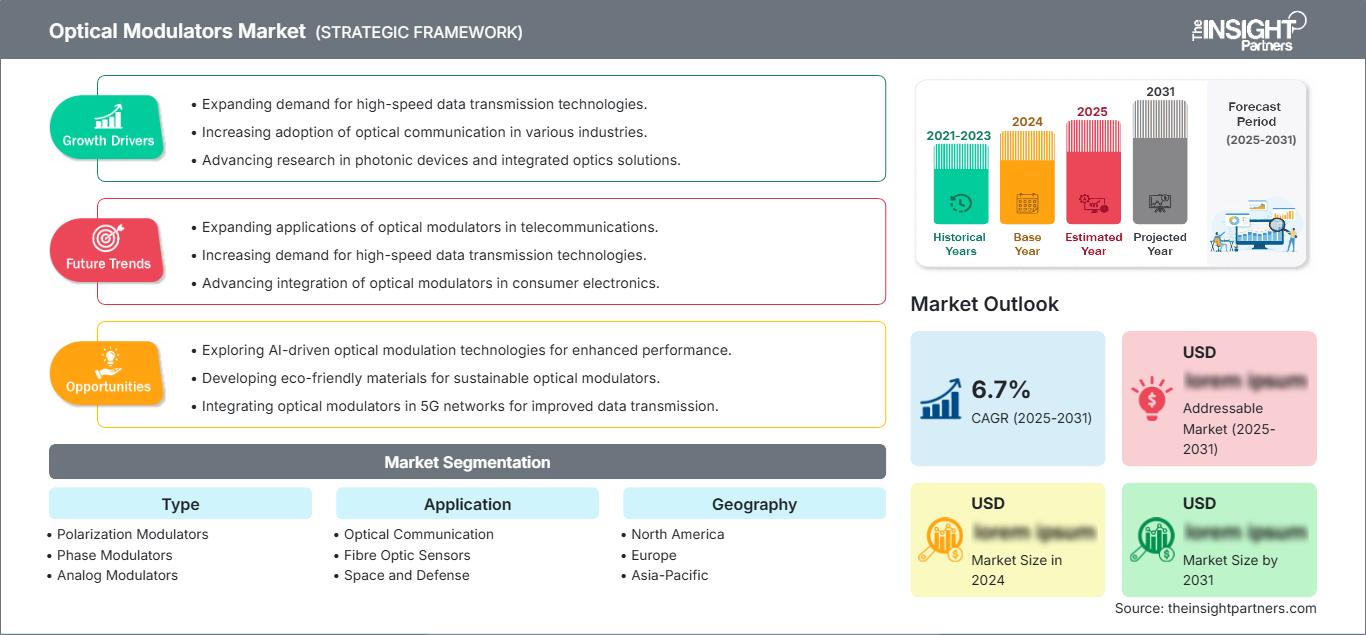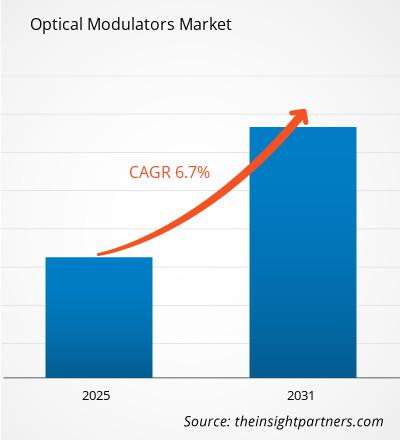Der Markt für optische Modulatoren wird voraussichtlich zwischen 2025 und 2031 eine durchschnittliche jährliche Wachstumsrate (CAGR) von 6,7 % verzeichnen, wobei die Marktgröße von XX Millionen US-Dollar im Jahr 2024 auf XX Millionen US-Dollar im Jahr 2031 anwachsen wird.
Der Bericht ist segmentiert nach Typ (Polarisationsmodulatoren, Phasenmodulatoren, analoge Modulatoren, sonstige); Anwendung (optische Kommunikation, faseroptische Sensoren, Raumfahrt und Verteidigung, industrielle Systeme, sonstige); Geografie (Nordamerika, Europa, Asien-Pazifik, Naher Osten und Afrika, Süd- und Mittelamerika). Die globale Analyse ist weiter auf regionaler Ebene und nach den wichtigsten Ländern aufgeschlüsselt. Der Bericht bietet den Wert in USD für die obige Analyse und Segmente.
Zweck des Berichts
Der Bericht „Markt für optische Modulatoren“ von The Insight Partners zielt darauf ab, die aktuelle Situation und das zukünftige Wachstum sowie die wichtigsten treibenden Faktoren, Herausforderungen und Chancen zu beschreiben. Dadurch erhalten verschiedene Geschäftsinteressenten Einblicke, beispielsweise:
- Technologieanbieter/-hersteller: Um die sich entwickelnde Marktdynamik zu verstehen und die potenziellen Wachstumschancen zu kennen, sodass sie fundierte strategische Entscheidungen treffen können.
- Investoren: Um eine umfassende Trendanalyse hinsichtlich der Marktwachstumsrate, der finanziellen Marktprognosen und der Chancen entlang der Wertschöpfungskette durchzuführen.
- Regulierungsbehörden: Um Richtlinien und Überwachungsaktivitäten auf dem Markt zu regulieren, mit dem Ziel, Missbrauch zu minimieren, das Vertrauen der Investoren zu wahren und die Integrität und Stabilität des Marktes aufrechtzuerhalten.
Marktsegmentierung für optische Modulatoren: Typ
- Polarisationsmodulatoren
- Phasenmodulatoren
- Analogmodulatoren
- Sonstige
Anwendung
- Optische Kommunikation
- Lichtwellenleitersensoren
- Raumfahrt und Verteidigung
- Industrielle Systeme
- Sonstige
Sie erhalten kostenlos Anpassungen an jedem Bericht, einschließlich Teilen dieses Berichts oder einer Analyse auf Länderebene, eines Excel-Datenpakets sowie tolle Angebote und Rabatte für Start-ups und Universitäten.
Markt für optische Modulatoren: Strategische Einblicke

-
Holen Sie sich die wichtigsten Markttrends aus diesem Bericht.Dieses KOSTENLOSE Beispiel umfasst Datenanalysen, die von Markttrends bis hin zu Schätzungen und Prognosen reichen.
Wachstumstreiber für optische Modulatoren
- Steigende Nachfrage nach Hochgeschwindigkeitsdatenübertragung: Das exponentielle Wachstum des Datenverkehrs aufgrund der zunehmenden Beliebtheit von Cloud Computing, 5G-Netzwerken und IoT treibt den Markt für optische Modulatoren an. Optische Modulatoren sind wichtige Komponenten in optischen Kommunikationssystemen, die elektrische Signale in optische Signale für die Hochgeschwindigkeitsdatenübertragung umwandeln. Die Nachfrage nach fortschrittlichen optischen Modulatoren wird hoch bleiben und weiter steigen, da Betreiber von Telekommunikations- und Rechenzentren sowohl die Bandbreite als auch die Kommunikationsgeschwindigkeit verbessern möchten.
- Wachstum der Telekommunikationsinfrastruktur: Laufende Entwicklungen und Modernisierungen der Telekommunikationsinfrastruktur, vor allem in Entwicklungsländern, fördern die Nachfrage nach optischen Modulatoren. Der Wechsel von konventionellen kupferbasierten Netzwerken zu Glasfasernetzwerkinfrastrukturen erhöht den Bedarf an optischen Modulatoren zur Unterstützung von Fernkommunikations- und Datenübertragungskapazitäten. Dies ist einer der Treiber für den Markt, da die Betreiber in die Modernisierung ihrer Systeme investieren, um dem höheren Datenbedarf gerecht zu werden.
Markttrends für optische Modulatoren – Zukunftstrends
- Steigende Nachfrage nach optischen Modulatoren auf Siliziumbasis: Es gibt einen zunehmenden Trend zu optischen Modulatoren auf Siliziumbasis, da ihre Herstellung und Entwicklung bestehende Halbleiterherstellungsprozesse nicht wesentlich verändern. Siliziumphotonik bietet Kosteneffizienz, Skalierbarkeit und Integrierbarkeit mit elektronischen Schaltungen. Da Kompaktheit und Effizienz wichtige Kriterien für optische Geräte in Telekommunikations- und Datenkommunikationsanwendungen werden, werden siliziumbasierte Modulatoren in solchen Anwendungen zunehmend eingesetzt.
- Fortschritte in der Siliziumphotonik für verbesserte Kommunikation: Die wachsende Nachfrage nach schnellen, energieeffizienten Kommunikationssystemen treibt die Einführung optischer Modulatoren auf Siliziumbasis voran. Ihre Kompatibilität mit bestehenden Halbleiterherstellungsprozessen und die Fähigkeit zur Integration mit elektronischen Schaltungen machen sie ideal für Telekommunikations- und Datenkommunikationsnetzwerke der nächsten Generation. Dieser Trend wird Innovationen bei optischen Verbindungen und skalierbaren, kostengünstigen Lösungen fördern.
Marktchancen für optische Modulatoren
- Neue Anwendungen im Quantencomputing: Quantencomputing allein bietet dem Markt für optische Modulatoren eine Nischenchance. Quantenkommunikationssysteme erfordern hochpräzise und zuverlässige optische Modulation, um Quantenzustände über große Entfernungen zu übertragen. Mit fortschreitender Forschung und Entwicklung in der Quantentechnologie entsteht daher ein Bedarf an spezifischen optischen Modulatoren, die strengen Anforderungen gerecht werden – ein weiterer Wachstumsbereich.
- Integration mit photonischen integrierten Schaltkreisen (PICs): Optische Modulatoren, die in photonische integrierte Schaltkreise integriert sind, bieten Herstellern enorme Chancen. Durch die Platzierung von Modulatoren in PICs können Unternehmen kompakte Hochleistungslösungen entwickeln, die die Funktionalität verbessern und die Systemkomplexität reduzieren. Dieser Trend folgt der Miniaturisierung und zunehmenden Integration und ermöglicht effizientere Designs in den Bereichen Telekommunikation, Rechenzentren und Unterhaltungselektronik.
Markt für optische Modulatoren
Die Analysten von The Insight Partners haben die regionalen Trends und Faktoren, die den Markt für optische Modulatoren im Prognosezeitraum beeinflussen, ausführlich erläutert. In diesem Abschnitt werden auch die Marktsegmente und die geografische Lage optischer Modulatoren in Nordamerika, Europa, im asiatisch-pazifischen Raum, im Nahen Osten und Afrika sowie in Süd- und Mittelamerika erörtert.Umfang des Marktberichts zu optischen Modulatoren
| Berichtsattribut | Einzelheiten |
|---|---|
| Marktgröße in 2024 | US$ XX million |
| Marktgröße nach 2031 | US$ XX Million |
| Globale CAGR (2025 - 2031) | 6.7% |
| Historische Daten | 2021-2023 |
| Prognosezeitraum | 2025-2031 |
| Abgedeckte Segmente |
By Typ
|
| Abgedeckte Regionen und Länder |
Nordamerika
|
| Marktführer und wichtige Unternehmensprofile |
|
Dichte der Marktteilnehmer für optische Modulatoren: Verständnis ihrer Auswirkungen auf die Geschäftsdynamik
Der Markt für optische Modulatoren wächst rasant. Die steigende Nachfrage der Endverbraucher ist auf Faktoren wie veränderte Verbraucherpräferenzen, technologische Fortschritte und ein stärkeres Bewusstsein für die Produktvorteile zurückzuführen. Mit der steigenden Nachfrage erweitern Unternehmen ihr Angebot, entwickeln Innovationen, um den Bedürfnissen der Verbraucher gerecht zu werden, und nutzen neue Trends, was das Marktwachstum weiter ankurbelt.
- Holen Sie sich die Markt für optische Modulatoren Übersicht der wichtigsten Akteure
Wichtige Verkaufsargumente
- Umfassende Abdeckung: Der Bericht analysiert umfassend Produkte, Dienstleistungen, Typen und Endnutzer des Marktes für optische Modulatoren und bietet einen ganzheitlichen Überblick.
- Expertenanalyse: Der Bericht basiert auf dem umfassenden Verständnis von Branchenexperten und Analysten.
- Aktuelle Informationen: Der Bericht gewährleistet Geschäftsrelevanz durch die Berichterstattung über aktuelle Informationen und Datentrends.
- Anpassungsoptionen: Dieser Bericht kann an spezifische Kundenanforderungen angepasst werden und passt sich optimal an die Geschäftsstrategien an.
Der Forschungsbericht zum Markt für optische Modulatoren kann daher dazu beitragen, die Branchensituation und die Wachstumsaussichten zu entschlüsseln und zu verstehen. Obwohl es einige berechtigte Bedenken geben kann, überwiegen die Vorteile dieses Berichts tendenziell die Nachteile.
- Historische Analyse (2 Jahre), Basisjahr, Prognose (7 Jahre) mit CAGR
- PEST- und SWOT-Analyse
- Marktgröße Wert/Volumen – Global, Regional, Land
- Branchen- und Wettbewerbslandschaft
- Excel-Datensatz
Aktuelle Berichte
Erfahrungsberichte
Grund zum Kauf
- Fundierte Entscheidungsfindung
- Marktdynamik verstehen
- Wettbewerbsanalyse
- Kundeneinblicke
- Marktprognosen
- Risikominimierung
- Strategische Planung
- Investitionsbegründung
- Identifizierung neuer Märkte
- Verbesserung von Marketingstrategien
- Steigerung der Betriebseffizienz
- Anpassung an regulatorische Trends






















 Kostenlose Probe anfordern für - Markt für optische Modulatoren
Kostenlose Probe anfordern für - Markt für optische Modulatoren